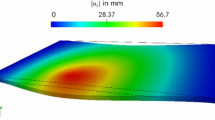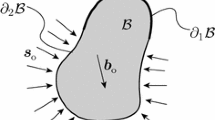Abstract
Using the “base forces” as the fundamental unknowns to determine the state of an elastic system, the complementary energy principle for large elastic deformation is constructed for the conjugate quantities being displacement gradients, which possesses exactly the same form as that of classical linear elasticity. It is revealed that the complementary energy contains deformation part and rotation part.
Similar content being viewed by others
References
Hellinger E. Der allgemein Ansatz der Machanik der Kontinua. Encyclopqdia der Mathematischen Wissenschaften, 1914, 4: 602
Reissner E. On a variational theorem for finite elastic deformation. J Math Phys, 1953, 32: 129–135
Levinson M. The complementary energy theorem in finite elasticity. J Appl Mech, 1965, 32: 826–828
Washizu K. Variational Methods in Elasticity and Plasticity. Oxford: Pergamon press, 1968
Zubov L M. The stationary principle of complementary work in nonlinear theory of elasticity. Prikl Mat Mech, 1970, 34: 228–232
Koiter W T. On the principle of stationary complementary energy in the nonlinear theory of elasticity. SIAM J Appl Math, 1973, 25: 424–434
Ogden R W. A note on variational theorems in non-linear elastostatics. Math Proc Camb Philos Soc, 1975, 77: 609–615
Ogden R W. Inequalities associated with the inversion of elastic stress deformation relation and their implications. Math Proc Camb Philos Soc, 1977, 81: 313–324
Guo Z H. Non-linear Theory of Elasticity (in Chinese). Beijing: Science Press, 1980. 218–240
Atluri S N. On some new general and complementary energy theorems for the rate problems in finite strain, classical elasticity. J Struct Mech, 1980, 8: 62–91
Gao D Y, Strang G. Geometric nonlinearity: Potential energy, complementary energy and the gap function. Q Appl Math, 1989, 47(3): 487.
Gao D Y. Pure complementary energy principle and triality theory in finite elasticity. Mech Res Commun, 1999, 26: 31–37
Fraeijs de Veubeke B M. A new variational principle for finite elastic displacements. Int J Eng Sci, 1972, 10: 745–763
Gao Y C. A new description of stress state at a point with applications. Arch Appl Mech, 2003, 73: 171–183
Gao Y C, Gao T J. Large deformation contact of a rubber notch with a rigid wedge. Int J Solids Struct, 2000, 37: 4319–4334
Gao Y C. Asymptotic analysis of the nonlinear Boussinesq problem for a kind of incompressible rubber material (compression case). J Elast, 2001, 64: 111–130
Gao Y C. Foundation of Solid Mechanics (in Chinese). Beijing: Railway Publisher of China, 1999
Author information
Authors and Affiliations
Rights and permissions
About this article
Cite this article
Gao, Y. Complementary energy principle for large elastic deformation. SCI CHINA SER G 49, 341–356 (2006). https://doi.org/10.1007/s11433-006-0341-7
Received:
Accepted:
Issue Date:
DOI: https://doi.org/10.1007/s11433-006-0341-7




